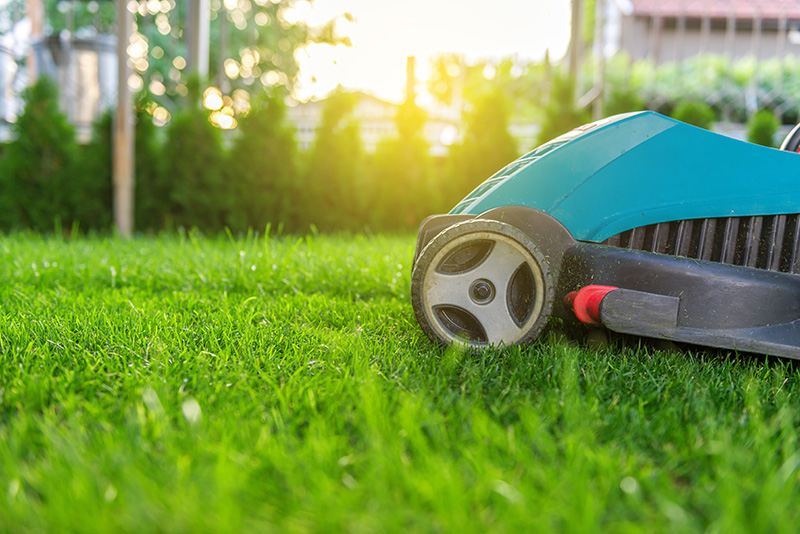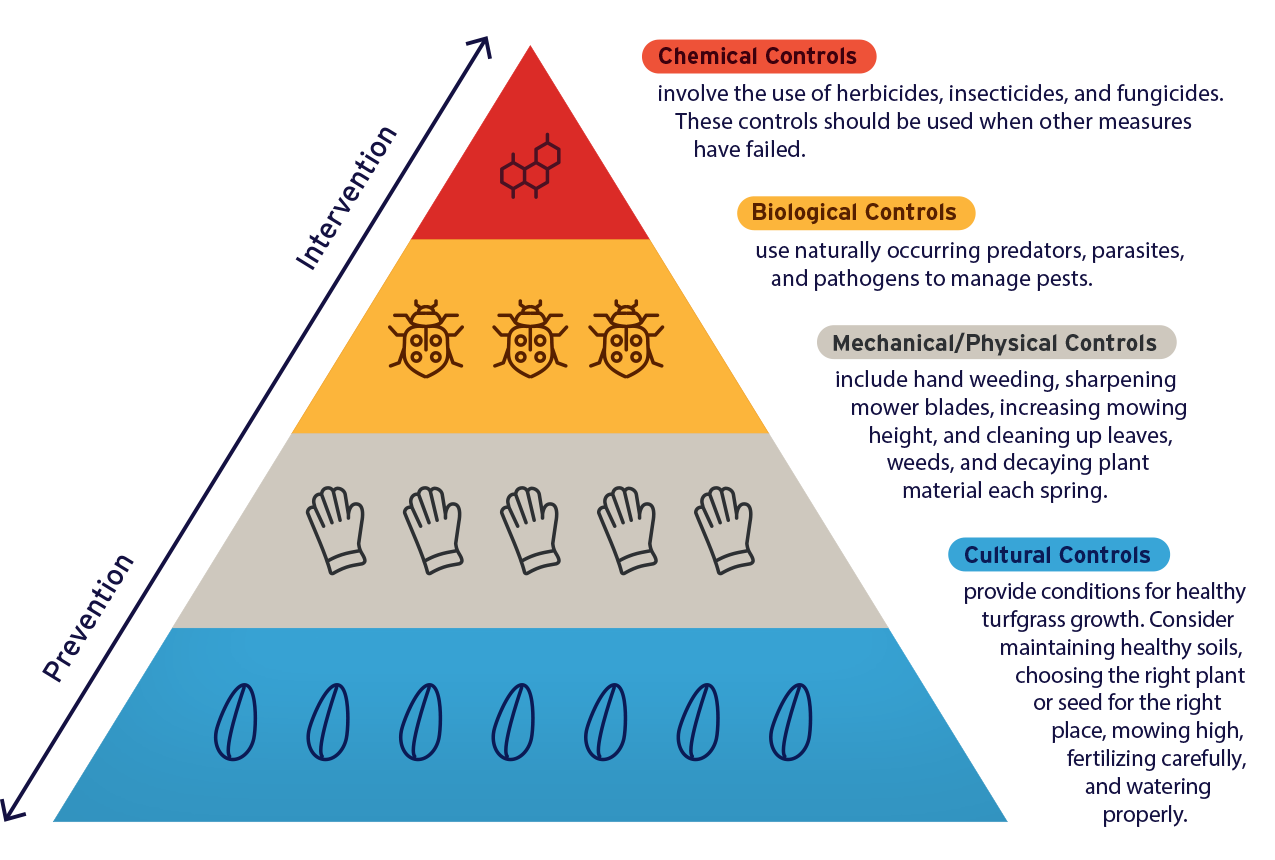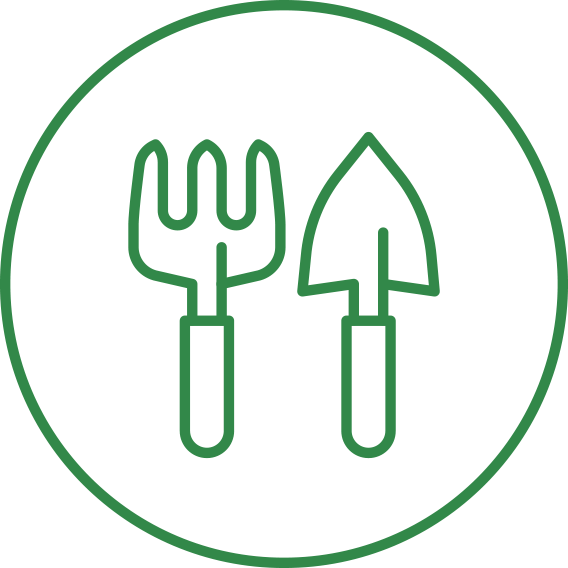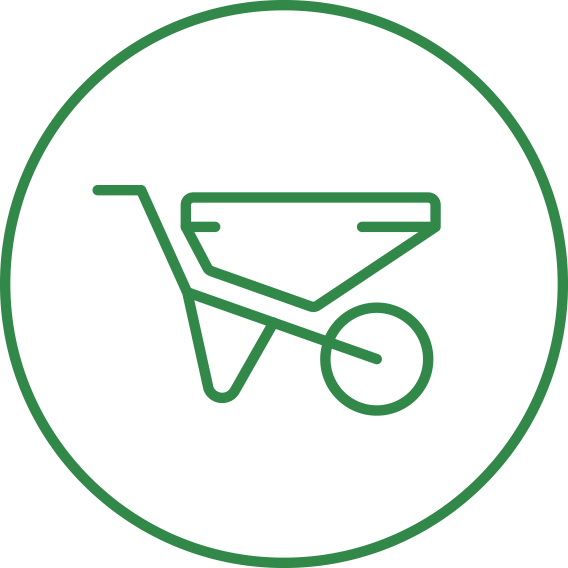Practice Integrated Pest Management
People caring for their home lawns have several pest management options that don’t rely on pesticide use. These options, which take into account pest, beneficial insect, and plant life cycles and behavior, are the key components of Integrated Pest Management (IPM).
First, DIY lawn caretakers must decide what their tolerance is for lawn pests, consider the purpose of their lawn, and determine how much damage they are willing to allow. Before reaching that limit, known as an action threshold, practice IPM.
IPM is an approach to managing pests that focuses on pest prevention. It relies on regular monitoring for early detection of damage and the use of cultural, mechanical/physical, and biological control methods to support a healthy lawn. To reduce risks, the use of chemical control methods (pesticides) is selective and targeted. These methods are described further in the following sections and in the IPM Pyramid.
Prevent
A preventive action plan is the recipe for a dense and healthy lawn that recovers more quickly from damage and outcompetes pests. These steps are considered cultural controls in the IPM model.
- Mow high to shade out weeds and promote deep, healthy roots.
- Sharpen mower blades to ensure a clean, attractive cut that allows grass to recover more quickly.
- Plant the best adapted turfgrass species for your site’s requirements.
- Overseed thinned areas to keep your lawn thick and able to outcompete weeds.
- Core aerate your lawn at least once a year to reduce compacted soils.
- Use soil testing results to determine nutrient needs and fertilize appropriately. Consider fertilizers derived from animal and plant material.
- Leave grass clippings and mulched leaves on your lawn to improve overall soil health.
Monitor
- Careful and frequent examination of your lawn and site conditions will allow you to identify pest presence, quantity, and any damage before it becomes widespread.
- Test your soil every 3-5 years.
- Scout for problem areas once or twice a month.
- Monitor and assess when pests approach damaging levels.
- Observe weather patterns and the time of year certain pests appear.
- Monitor rainfall and supplement by watering deeply and infrequently.

Careful monitoring of your lawn is your first defense against pests and will allow you to spot infestations before they become widespread problems. | Photo Credit: Shutterstock
Mowing Height
Mowing height depends on your lawn’s grass species. Mowing below the optimum height can restrict root growth, encourage weed growth, and increase susceptibility to drought, disease, insects, and foot traffic. If your lawn is shaded, mow it 1/2-1 inch higher than the recommendations below.
| SPECIES | HEIGHT (Inches) |
|---|---|
| Kentucky bluegrass | 2 to 3.5 |
| Perennial ryegrass | 2 to 3.5 |
| Fine fescue | 2 to 3.5 |
| Tall fescue | 2.5 to 4 |
| Zoysiagrass | 1.0 to 2.0 |
| Bermudagrass (common) | 1.5 to 2.5 |
Control
What is your tolerance for lawn pests? Consider the purpose of your lawn and determine how much damage you are willing to tolerate. Before you reach your threshold, apply the IPM model by using cultural, mechanical/physical, and biological controls before resorting to chemical options. These strategies focus on preventative practices that ultimately lead to less need for pesticide intervention. In many cases, a combination of these strategies will be necessary.
IPM Pyramid

Adapted from Pennsylvania State University’s Integrated Pest Management Brochure. Designed by Joel Davenport, Illinois-Indiana Sea Grant.
- Cultural Controls provide conditions for healthy turfgrass growth and disrupt or reduce pest populations. Consider maintaining healthy soils, mowing high, fertilizing carefully, and watering properly. Choosing the right plant or seed for the right place is another important cultural control. Select and use plant species that are compatible with the existing conditions and consider disease and/or insect resistant varieties.
- Mechanical/Physical Controls use barriers or traps to exclude or catch pests. This includes hand weeding, sharpening mower blades, increasing mowing height, and cleaning up leaves, weeds, and decaying plant material each spring.
- Biological Controls use naturally occurring predators, parasites, and pathogens to manage pests. These types of control are less available for turfgrass, so consult a professional for more information.
- Chemical Controls involve the use of herbicides, insecticides, and fungicides. These controls should be used when other measures have failed. The least toxic pesticide should be used initially and labels carefully followed.
Using IPM is the best way to safe, long-term pest management with minimal adverse effects to your family and the surrounding environment.
ADDITIONAL RESOURCES
Managing Lawn Pests with Fewer Chemicals Brochure
Natural Lawn Care, Site Assessment and Action Plan
Turfgrass Science at Purdue: Weed of the Month
Cornell University: Turfgrass and Landscape Weed ID








